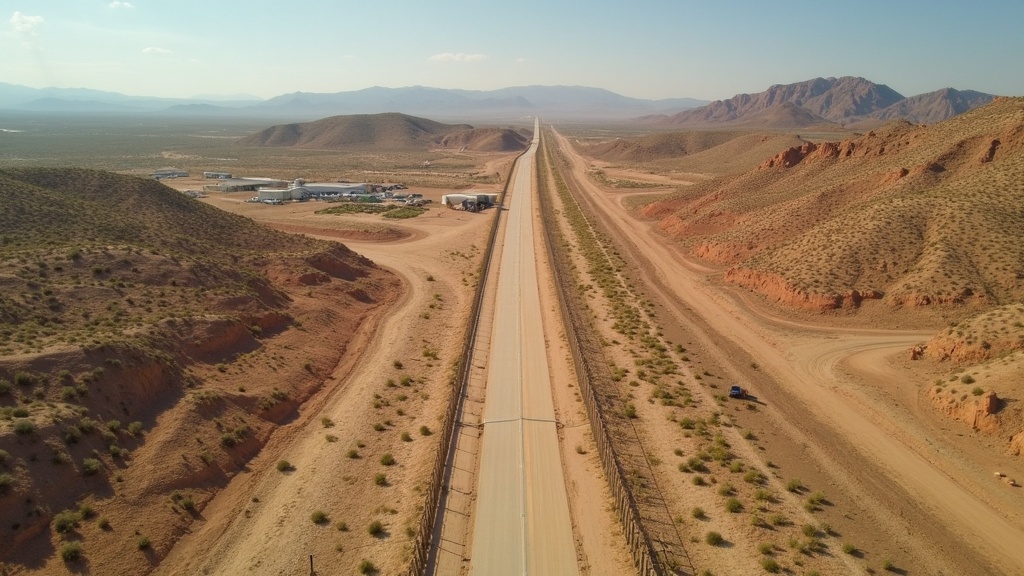Introduction
Borders aren’t just lines on the map; they’re ground zero for a specific set of crimes, including the Most Common Types Of Border Crimes, that can have far-reaching effects, even for people who don’t live anywhere close to an international boundary. Border crimes go way beyond a single illegal crossing or isolated incident. These crimes often involve organized networks and can ripple through communities, touching on everything from economic conditions to safety in a local neighborhood. While law enforcement is on the front lines, border crimes shape economies, drive policy debates, and influence daily life everywhere.

Table of Contents
What Are Border Crimes?
Border crimes are any criminal activities that take advantage of international boundaries. This can include everything from smuggling and trafficking to money laundering and fraud. What stands out with these crimes is their transnational nature; they don’t just stop at the border. There’s usually organized crime involved, and the rewards can be high, which means the risks to communities are high as well.
Borders are a prime target because of their location, the tremendous amount of legal trade and travel, the opportunities for corruption, and often limited resources for oversight. Criminal networks know this, so they adapt and cook up something new constantly to slip past enforcement efforts. Communities, both close to and far from the border, feel the impacts, making border crimes a national concern.
Drug Trafficking
Drug trafficking at borders involves all sorts of sneaky tactics, like vehicles with secret compartments or elaborate tunnels running between countries. Smugglers stay creative, even using drones or small boats to bypass official checkpoints. One eye-catching new method is using drones to deliver drugs over border fences in under a minute. These deliveries are quick and tough to stop.
On the ground, border towns often struggle with cartel violence, with local safety at stake and residents sometimes facing intimidation or property crime linked to drug operations. Across the country, communities see the effects through rising opioid addiction, record-breaking fentanyl overdoses, and emergency rooms filled with overdose cases. For example, fentanyl seizures at ports of entry have soared in recent years, fueling a national crisis and stretching both healthcare and law enforcement resources thin. Neighbors are impacted by a steady stream of new drugs that might not have been present before.
Human Smuggling and Human Trafficking
Human smuggling means people pay guides—often called coyotes—to cross borders illegally. Trafficking goes further; people are forced, tricked, or coerced into labor or sex work under harsh conditions. These crimes almost always focus on profit over people’s safety, putting individuals at serious risk.
Communities along the border may notice more pressure placed on shelters and social services as large groups of people arrive at once. Migrants themselves are often exploited, facing dangerous work conditions or falling victim to labor and sex trafficking. Smuggling routes are also notoriously deadly, with many recorded cases of people perishing in trucks or remote deserts.
To fight back, police and federal agents sometimes put together joint task forces and use victim-centered strategies to go after traffickers, but the networks can be highly organized and hard to crack. This impacts not only border towns but also cities across the country that migrants often travel to after arriving.
Firearms Trafficking
While many people imagine smuggling as goods coming north, there’s a steady flow of guns heading south—from the U.S. into Mexico. Criminals buy guns in the U.S., sometimes using “straw purchasers,” and smuggle them across the border to resell or arm cartel groups. This arms pipeline is a big reason for rising violence in Mexico and along the border corridor. Even towns on the U.S. side sometimes deal with shootouts, illegal gun transfers, and violence tied to organized groups.
The U.S. Bureau of Alcohol, Tobacco, Firearms and Explosives (ATF) works to disrupt these flows by strengthening export controls and prosecuting illegal buyers. Still, the problem is complex, requiring ongoing efforts and cross-border collaboration between law enforcement agencies from different countries.
Fuel and Commodity Smuggling
Not every border crime grabs attention, but plenty can strain a region’s economy and local budgets. Smuggling cheap diesel fuel, untaxed cigarettes, alcohol, or even agricultural products is big business. These items dodge taxes, hurting state and local revenues and making it harder for honest businesses to compete. In some communities, black market sales affect day-to-day prices, squeezing out legitimate sellers.
Profits from smuggled goods usually fund larger, more violent organized crime networks. This sets off a harsh cycle by strengthening criminal groups who turn their earnings into more illegal ventures, putting communities at further risk. State governments sometimes launch special enforcement initiatives to step up their response, but criminal operations tend to switch things up quickly to stay ahead.
Money Laundering and Trade-Based Fraud
Criminal networks have become pretty sophisticated at hiding cash. One strategy grabbing attention is trade-based money laundering, where criminal organizations use over- or under-invoicing of imports and exports, phantom shipments, or complex transactions to disguise the source of dirty money. Smugglers try to blend illicit proceeds into legitimate business transactions so they’re tougher to spot.
Bulk cash smuggling remains widespread; in 2023 alone, federal agents seized millions in hidden cash at vehicle checkpoints and airports. These schemes can leave legitimate businesses unable to keep up and may sour trust in banks or government institutions. In border regions, entire economic sectors risk being destabilized if a big laundering network is brought to light.
Counterfeit Goods and Intellectual Property Crime
Borders are a hotspot for moving fake goods—think knockoff electronics, medications, auto parts, and luxury items. These counterfeits might look convincing, but they’re often shoddily made and sometimes downright dangerous. Fake medicines can put lives in jeopardy, and counterfeit auto parts have failed in real crashes.
Counterfeits don’t just hurt legitimate businesses; they also bring in money for organized crime and in rare cases have supported terrorist activities. Customs agents try to spot and stop fake shipments, but with how much trade passes through, some are bound to sneak by. Online sales of counterfeit goods are also expanding, making enforcement tougher as more shopping switches to digital platforms.
Cyber-Enabled Border Crimes
Border crime isn’t just about physical goods anymore. Criminals use the dark web, encrypted apps, and anonymous marketplaces to coordinate illegal shipments and communicate. Drugs and weapons can be ordered from afar, sent through regular mail, and hidden in everyday packages. Smuggling groups use encrypted messaging apps to recruit mules and map out operations, sometimes never stepping foot near the actual border zone.
This digital shift means small towns can suddenly find themselves facing international cybercrime, something many local law enforcement agencies aren’t equipped to handle on their own. More specialized training and partnerships with federal agencies provide some help, but the tech landscape is always evolving.
Broader Community Impacts of Border Crimes
The reach of border crimes doesn’t end at the state line. Towns near the border often live with higher rates of gang activity, violence, and property crime. The opioid epidemic touches every corner of the country and is often linked back to trafficking networks working along the border. Residents may feel less safe walking around at night or sending their kids to public parks.
The fallout goes beyond safety. Higher public expenses mean less money for schools, parks, and roads as more funding gets directed toward law enforcement or emergency health responses. If corruption creeps into institutions, trust in government can tank, affecting community well-being and participation. Many advocacy groups now double down on transparency to prevent these risks from spiraling out of control.
Law Enforcement and Community Responses
Tackling border crimes takes an all-hands approach. Federal agencies like Customs and Border Protection (CBP), Homeland Security Investigations (HSI/ICE), the DEA, ATF, and FBI each bring skills and resources. State and local police often join forces in special task forces or cross-agency operations to pool knowledge and better respond to specific issues as they arise.
Community groups do their part by spreading awareness, supporting victims, and keeping the public informed. Their partnerships with agencies in Mexico and Canada are key for tracking new threats. Programs like neighborhood watch, school outreach, and bilingual educational hotlines smooth the way for information sharing and better safety for everyone.
Challenges in Combating Border Crimes
Policing the border is far from simple. Many agencies have a piece of the task, so some overlap or confusion can slow down efforts. The sheer volume is another hurdle; millions of vehicles and pedestrians cross legally every day, meaning it’s not possible to check every single one.
Meanwhile, criminals try new methods all the time, such as using more advanced tech or switching routes. Tight budgets and outdated equipment make it harder for law enforcement to keep up. Training and communication between agencies remain ongoing priorities, along with investing in smarter, faster detection systems.
Eye-Catching Innovations and Future Directions
Some of the most exciting solutions involve new technology. Agencies are putting AI and predictive analytics to work to spot smuggling trends before they happen. Biometric ID systems are showing up at more checkpoints, making it more difficult for anyone to cross using a fake identity. Tools like counter drone detection help fill gaps above the ground, while blockchain technology tracks goods to cut down on fraudulent shipments.
Building relationships with local leaders also matters. When residents trust police and border agents, they’re more likely to report suspicious activity early, making prevention more effective. Community forums, social media campaigns, and partnerships with businesses step up public involvement. As the landscape keeps evolving, authorities recognize the need to keep adapting through smart investment in both technology and people-focused solutions.
Frequently Asked Questions
What makes border crimes different from other crimes?
Border crimes take advantage of international boundaries and often involve organized networks determined to cross legal, geographic, and jurisdictional lines. This creates major hurdles for law enforcement, who have to stay sharp and flexible to keep up.
Why should I care about border crimes if I don’t live near the border?
These crimes have ripple effects, from higher crime rates to public safety threats, economic disruptions, increased drug availability, and overloaded social services. Even people far from any border might feel the impact in their daily lives.
Are communities doing anything to stop these crimes?
Yes. Communities support law enforcement with awareness campaigns, programs to help victims, and educational resources that teach people how to spot and report suspicious activity quickly. There’s a growing emphasis on local action and cross-border cooperation, too.
Border crimes come in many forms, touching on everything from neighborhood safety to economic stability, even when the border itself is hundreds of miles away. By staying informed, supporting local programs, and keeping an eye out for how these crimes operate, everyone can help protect their community a little bit more. Keeping an open dialogue, working together, and being resourceful are all key steps to safeguarding the places people call home.
If you feel like you need to report a crime involving money laundering, please don’t hesitate to contact your local law enforcement or, if in the United States, reach out to the Homeland Security Investigations or the Federal Bureau of Investigations.
Contact Us:
If you need to contact us for any reason, please feel free to do so here!






